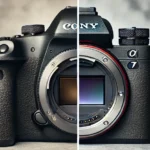DSLR vs. Mirrorless Cameras in 2024: A Comprehensive Guide
Introduction
The debate between DSLR (Digital Single-Lens Reflex) and mirrorless cameras has been ongoing for over a decade. As technology advances, so do the capabilities of these cameras. In 2024, the landscape has evolved significantly, with both types of cameras offering unique features that cater to different types of photographers. This article will explore the pros and cons of each camera type, focusing on their current status and suitability in 2024.
What Are DSLR and Mirrorless Cameras?
DSLR Cameras use a mirror mechanism to reflect light from the camera lens up into an optical viewfinder. This allows photographers to see exactly what the lens sees. When the shutter button is pressed, the mirror flips up, allowing light to hit the image sensor and capture the photo.
Mirrorless Cameras lack this mirror mechanism, allowing light to pass directly to the digital image sensor. This change leads to a more compact design and often allows for faster shooting speeds. Instead of an optical viewfinder, mirrorless cameras typically use an electronic viewfinder (EVF) or rely on the rear LCD screen.
Advancements in 2024: A Closer Look
1. Image Quality and Sensor Technology
- DSLRs: In 2024, DSLRs continue to offer exceptional image quality, especially in low-light situations. DSLRs like the Nikon D850 or Canon 5D Mark IV remain popular for their full-frame sensors and excellent dynamic range. For professional work that requires high-resolution images and reliable performance, DSLRs still hold their ground.
- Mirrorless: Mirrorless cameras have made significant strides in image quality. Leading brands like Sony, Canon, and Nikon have improved sensor technology, offering full-frame and even medium-format sensors in mirrorless models. The absence of a mirror means less vibration, which can result in sharper images, especially at slower shutter speeds. The electronic viewfinders (EVFs) now offer high resolutions and near-zero lag, providing an experience closer to that of an optical viewfinder.
2. Autofocus Performance
- DSLRs: Traditionally, DSLRs have been known for their fast and reliable autofocus systems, especially in low-light conditions. They use phase-detection autofocus (PDAF), which is quick and accurate, particularly when using the optical viewfinder. However, in 2024, this gap has narrowed significantly.
- Mirrorless: Mirrorless cameras have overtaken DSLRs in autofocus performance due to advanced PDAF and contrast-detection systems that work directly on the image sensor. With developments in AI and machine learning, modern mirrorless cameras offer features like eye and face detection, object tracking, and improved autofocus in low light. The autofocus coverage across the frame is also superior, making them ideal for action, wildlife, and sports photography.
3. Size and Portability
- DSLRs: DSLRs are known for their robust build quality and ergonomic grip, which is comfortable for extended use. However, this comes at the cost of size and weight. In 2024, DSLRs are still bulkier than mirrorless cameras, which may not be ideal for travel or street photographers who prefer a more discreet and lightweight setup.
- Mirrorless: Mirrorless cameras are compact and lightweight, making them a favorite among travel and street photographers. The absence of a mirror mechanism reduces their size and weight, providing a more portable solution without sacrificing image quality. In 2024, advancements in battery technology have also mitigated the shorter battery life that was a concern in earlier models.
4. Battery Life
- DSLRs: Due to their optical viewfinders, DSLRs tend to have longer battery life compared to mirrorless cameras. They do not require power for an electronic viewfinder, which allows for extended shooting sessions. Even in 2024, professional photographers who need long battery life for events or wildlife photography still prefer DSLRs for this reason.
- Mirrorless: Battery life has been a point of contention for mirrorless cameras, but in 2024, significant improvements have been made. Modern mirrorless cameras now offer more efficient power management and extended battery life, closing the gap with DSLRs. USB-C charging options have also become standard, allowing for easy recharging on the go.
5. Lens Availability and Compatibility
- DSLRs: DSLRs have been around for a long time, which means there is an extensive selection of lenses available. From entry-level to professional-grade lenses, DSLR users have access to a wide range of options. Additionally, the second-hand market for DSLR lenses is thriving, offering affordable choices for budget-conscious photographers.
- Mirrorless: Mirrorless cameras are catching up quickly in terms of lens availability. Major manufacturers like Sony, Canon, and Nikon have expanded their mirrorless lens lineups significantly. In 2024, many third-party lens manufacturers, like Sigma and Tamron, also offer high-quality options for mirrorless mounts. Lens adapters make it possible to use DSLR lenses on mirrorless bodies, providing flexibility for those transitioning from DSLR to mirrorless.
6. Price Considerations
- DSLRs: In 2024, DSLRs tend to be more affordable than their mirrorless counterparts, particularly at the entry and mid-range levels. For beginners or hobbyists looking for high-quality cameras without breaking the bank, DSLRs offer a solid choice.
- Mirrorless: Mirrorless cameras, especially the latest models, can be more expensive than DSLRs due to advanced features and technology. However, the price gap is narrowing as the market becomes more competitive. Additionally, the long-term benefits of compact size, advanced autofocus, and electronic viewfinders may justify the higher initial cost for many photographers.
Conclusion: Which One Should You Choose in 2024?
In 2024, the decision between DSLR and mirrorless cameras depends largely on individual needs and preferences:
- Choose a DSLR if you value longer battery life, a robust build, an optical viewfinder, and access to a wide range of lenses at potentially lower costs.
- Choose a Mirrorless Camera if you want cutting-edge autofocus, a more compact and lightweight design, real-time previews via electronic viewfinders, and future-proofing with the latest technological advancements.
Both DSLR and mirrorless cameras have their place in the photography world in 2024. While mirrorless technology is rapidly advancing and gaining popularity, DSLRs remain reliable workhorses for many photographers. Ultimately, the best choice is the one that aligns with your specific photography style, needs, and budget.
Wedding Photographers in Lucknow Random Clicks Photography By Atul Ghosh & Vartika Jain







